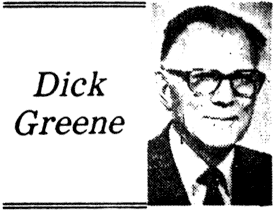[Newspaper]
Publication: The Muncie Star
Muncie, IN, United States
Seen and Heard in
Our Neighborhood
 |
MUNCIE MEMENTOES . . . Tracking a bear in Vilas County in northern Wisconsin, Don Johnson, of Muncie, came upon a utility pole almost completely buried in the sand.
Examining the pole and its cross arm, Johnson found four glass insulators attached to upright pegs. Removing them and scrutinizing them, he saw embossed letters and numerals: "Hemingray 16" on one side and "Made in USA" on the other.
THEY WERE a reminder of Muncie, which for years was the home of Hemingray Glass Co., a firm that in later years became a division of Owens-Illinois Co. The biographical volume of Haimbaugh's History of Delaware County (1924) reads that the Hemingray firm had its inception in Cincinnati in 1848, afterwards was in business in Covington, Ky. and moved to Muncie in 1888.
IT MANUFACTURED glass insulators and was the largest producer of them in the world. The plant under its last ownership ceased manufacture of glass in July, 1972, and transferred operations to units of the company in other cities.
ERN PARKISON, who was a supervisor with the firm 41 years, says the No. 16 on the insulators found by Johnson indicates they were used on telephone toll lines between cities.
Don Johoson, a lieutenant colonel, was a pilot in the Air Force during World War II and had served 17 years at retirement.
A RECENT VISITOR in Muncie was a former resident, Charles E. Roush, now of Kewanna, where he is principal of Union Township School, Fulton County. He has followed the footsteps of his father, Charles G. Roush, who at the time of his unexpected death in 1934 was principal of Harrison elementary school. Charles is visiting his sister, Alma Roush Petro and husband, Kenneth J. Petro, 4300 Riverside Ave. "Pete" is a retired school principal.
A graduate of Ball State Unrversity and veteran of World War II, Charles Roush has been in school work 30 years. He and wife, Jane Maddox Roush, formerly of Hartford City, have three children.
"KEWANNA" sounds like an Indian name ... so let's check to be sure.
Consulting the glossary of Indiana names in Jacob Piatt Dunn's "True Indian Stories," we find it is "the Potawatomi name of the prairie chicken and also means 'lost'."
Dunn adds: "The word is very similar to the Miami, which means 'nose'."
● ● ●
A REPORT of interest to the historian as well as to the archeologist was compiled and published, recently under the direction of Dr. B. K. Swartz Jr., professor of anthropology at Ball State University.
It is No. 14 in the university archeological series and is titled, "Ethnohistorical and Archeological Descriptive Accounts of the War of 1812. Mississinewa Campaign and Aftermath: Project Report." Associated with Dr. Swartz were Elizabeth J. Glenn and Russell E. Lewis, both of whom along with Swartz wrote articles.
THE HISTORICAL ASPECT is significant since the Battle of the Mississinewa Dec. 18,1812, was the only battle of the War of 1812 fought on Indiana soil. The site is in Grant County seven miles or so northwest of Marion.
The 325-page publication gives accounts of the campaign, purpose of battle, participants' reports, the battle and the aftermath. It describes and locates Miami Indian villages and documents the artifacts found in the areas examined. Also it reports on the field school conducted by Ball State from June 9 to July 11, 1976.
The person interested in Indiana history will welcome this as a valued addition to his shelf of materials.